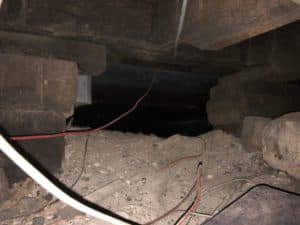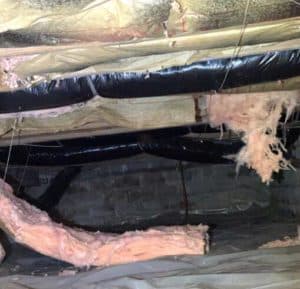
Originally posted 4/17/18, revised 10/8/20
When I work on articles about crawl spaces, sometimes I feel like a hack writing commercials for a C grade monster movie: “It’s a cramped, seldom-traveled space, with unseen creatures lurking in the dark.” Of course, I’m an arachnophobic who enthusiastically reads Stephen King, so it may be wishful thinking.
Putting aside my own love of horror novels, there is some truth to this; crawl spaces are often small or inaccessible, people rarely go in them, and there can be pests and worse inside. Acculevel is a family-owned and operated company that specializes in waterproofing and foundation repair. Our project managers and work crews have been in many thousands of crawl spaces, and we know these often-ignored spaces can have a significant and damaging effect on the overall health of your home.
We’re going to define a crawl space, explain their purpose, and what potential problems can develop inside a crawl space. Along the way, we’ll provide you with some additional resources that can help you protect your home and its foundation.
 This crawl space photo was taken by an Acculevel project manager during a free estimate. Moisture has caused the joists and beam to rot.
This crawl space photo was taken by an Acculevel project manager during a free estimate. Moisture has caused the joists and beam to rot.
When your home was built, concrete footers were poured. Your foundation was built on top of these footers, and the builder probably started the flooring structure of your home a few feet off the ground. They left an empty space between the ground and the floor, and this is what’s called the crawl space.
Optimally, a crawl space is at least three feet tall. This gap allows air to circulate around your home, keeps the flooring dry, and provides space for insulation. It’s also usually where you access your utilities: plumbing, electrical wiring, ductwork, etc. Another purpose of a crawl space is to keep your house elevated off the ground. The flooring of your home is built on a wooden structure, and you don’t want it having direct contact with damp earth.
Since a crawl space is next to -or partially under- the ground, it’s within easy reach of many invaders looking for a home out of the weather.
 This photo was taken by an Acculevel project manager during a free estimate. The vapor barrier needs to be replaced, and the old fiberglass insulation removed.
This photo was taken by an Acculevel project manager during a free estimate. The vapor barrier needs to be replaced, and the old fiberglass insulation removed.
If your crawl space is currently pest-free and dry, you’ll want to keep it that way. At the very minimum, you should have a vapor barrier installed. This is a plastic sheeting that covers the ground and inhibits moisture evaporation from the ground getting into your crawl space. You should also have a proper door or entry into the crawl space. This will discourage small animals from entering, and prevent larger ones entirely.
But if you have unwelcome guests or standing water, you’ll need to begin with eviction proceedings. Find quality professionals that can treat insect infestations, or trap and remove animals. If the crawl space has flooded or standing water in it, you’ll need to have it drained.
Once these things are accomplished, find a reliable and experienced foundation company to evaluate the crawl space. There may be damage to the wooden flooring structure or the foundation itself, which should be repaired promptly.
If you are interested in performing your own foundation inspection, we have a guide that will help you. This is based on our own 21 Point Inspection Plan, which costs $500 for 5 years. But this checklist is available to you, free of charge.
Will this be the first time you’ve worked with a contractor on home repair? Or did your last experience not go as well as you’d hoped? Please use our guide to questions you should ask a contractor, with a free downloadable form.
If you are worried about your home and would like to take immediate action, find an experienced and knowledgeable foundation company to evaluate your home. Before you meet with a contractor of any kind, we urge you to verify that the company is reputable, insured, and accredited by the Better Business Bureau.
If you live in Indiana or the surrounding states, contact Acculevel. We are a family-owned and operated company, and we provide free written estimates. One of our experienced project managers will evaluate your foundation, basement or crawl space, then recommend the best course of action for you. Our goal is to help you keep your home strong and healthy for years to come.
[DISPLAY_ULTIMATE_SOCIAL_ICONS]